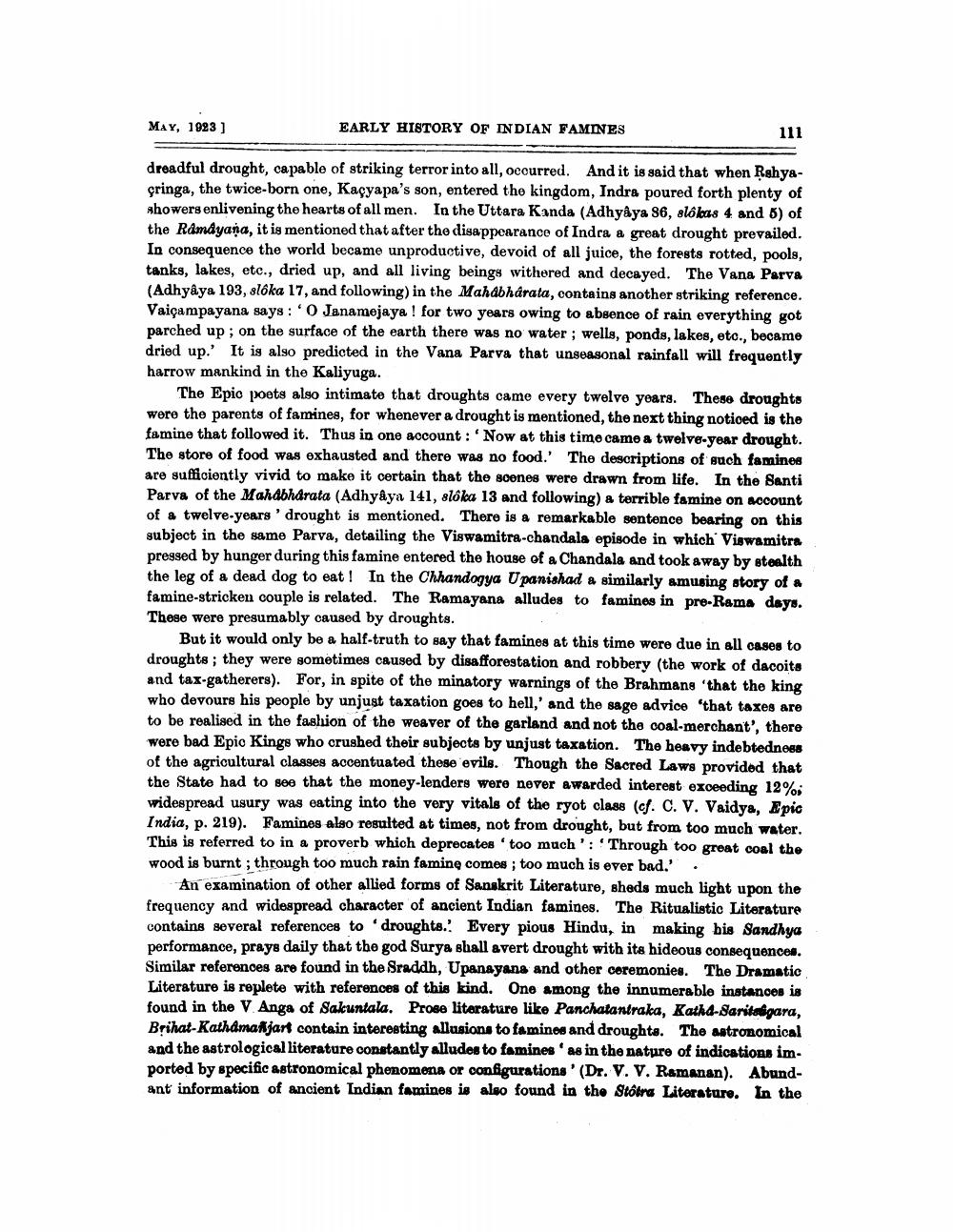________________
MAY, 1923)
EARLY HISTORY OF INDIAN FAMINES
111
dreadful drought, capable of striking terror into all, occurred. And it is said that when Rahyaçringa, the twice-born one, Kaçyapa's son, entered the kingdom, Indra poured forth plenty of showers enlivening the hearts of all men. In the Uttara Kanda (Adhyâya 86, elô las 4 and 6) of the Ramayana, it is mentioned that after the disappearance of Indra a great drought prevailed. In consequence the world became unproductive, devoid of all juice, the forests rotted, pools, tanks, lakes, etc., dried up, and all living beings withered and decayed. The Vana Parva (Adhyâya 193, sloka 17, and following) in the Mahabharata, contains another striking reference. Vaiçampayana says: 'O Janamejaya ! for two years owing to absence of rain everything got parched up ; on the surface of the earth there was no water; wells, ponds, lakes, etc., became dried up. It is also predicted in the Vana Parva that unseasonal rainfall will frequently harrow mankind in the Kaliyuga.
The Epic poets also intimate that droughts came every twelve years. These droughts were the parents of famines, for whenever a drought is mentioned, the next thing noticed is the famine that followed it. Thus in one account : 'Now at this time camo a twelve-year drought. The store of food was exhausted and there was no food.' The descriptions of such famines are sufficiently vivid to make it certain that the scenes were drawn from life. In the Banti Parva of the Mahabharata (Adhyâya 141, 8lóka 13 and following) a terrible famine on account of a twelve-years' drought is mentioned. There is a remarkable sentence bearing on this subject in the same Parva, detailing the Viswamitra-chandals episode in which Viswamitra pressed by hunger during this famine entered the house of a Chandala and took away by stealth the leg of a dead dog to eat! In the Chhandogya Upanishad a similarly amusing story of a famine-stricken couple is related. The Ramayana alludes to famines in pre-Rama days. These were presumably caused by droughts.
But it would only be a half-truth to say that famines at this time were due in all cases to droughts : they were sometimes caused by disafforestation and robbery (the work of dacoits and tax-gatherers). For, in spite of the minatory warnings of the Brahmang 'that the king who devours his people by unjust taxation goes to hell,' and the sage advice that taxes are to be realised in the fashion of the weaver of the garland and not the coal-merchant', there were bad Epic Kings who crushed their subjects by unjust taxation. The heavy indebtedness of the agricultural classes accentuated these evils. Though the Sacred Laws provided that the State had to see that the money-lenders were never awarded interest exceeding 12%; widespread ugury was eating into the very vitals of the ryot class (cf. C. V. Vaidya, Epic India, p. 219). Famines also resulted at times, not from drought, but from too much water. This is referred to in a proverb which deprecates too much ': 'Through too great coal the wood is burnt; through too much rain faming comes; too much is ever bad.
An examination of other allied forms of Sanskrit Literature, sheds much light upon the frequency and widespread character of ancient Indian famines. The Ritualistic Literature contains several references to droughts. Every pious Hindu, in making his Sandhya performance, praye daily that the god Surya shall svert drought with its hideous consequences. Similar references are found in the Sraddh, Upanayans and other ceremonies. The Dramatic Literature is replete with references of this kind. One among the innumerable instances is found in the V Anga of Sakuntala. Prose literature like Panchatantraka, Katha-Saritatigara, Brihat-Kathamafjart contain interesting allusions to famines and droughts. The astronomical and the astrological literature constantly alludes to famines 'as in the nature of indications imported by specific astronomical phenomena or configurations' (Dr. V. V. Ramanan). Abundant information of ancient Indian famines is also found in the Stótra Literature. In the




